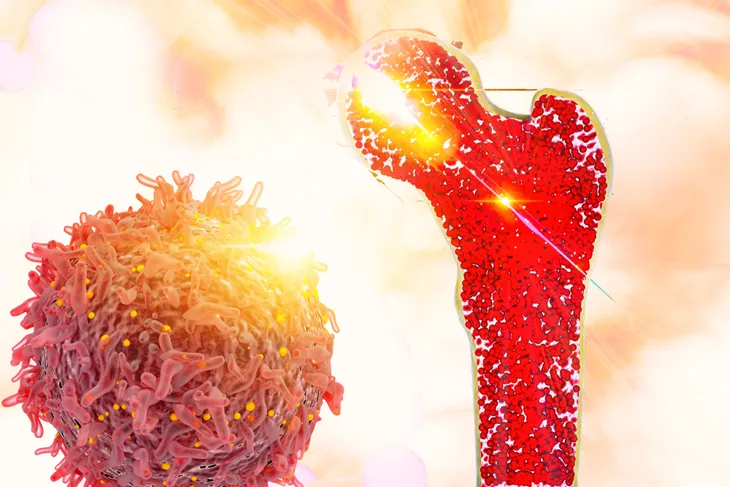Approximately 3,010 adults will be diagnosed with bone cancer this year, and more than 1,400 will die from the disease. There are several types of bone cancer. However, primary bone cancer, which results when a tumor grows inside a bone, and secondary bone cancer, which is caused when cancer cells spread from another part of the body into the adjacent bones, are the most prevalent.
The most unfortunate aspect of bone cancer, or any type of cancer, is that patients often don’t realize there is an issue until it’s too late. Don’t be a statistic! Don’t ignore the telltale symptoms of bone cancer…
1. Bone pain
Chronic pain is common to those with bone cancer, and it’s typically one of the first signs that bone cancer is present. Ongoing pain can result from the cancer tumor—either emanating from inside the affected bone or joint, from the tumor pressing on a nearby organ or nerve, or pain as a result of cancer treatment (i.e., radiation or chemotherapy). “It may be worse at night or when the bone is used, for instance, leg pain when walking. As the cancer grows, the pain will be there all the time, and get worse with activity,” writes the American Cancer Society.
2. Inflammation
Primary bone cancer results when a tumor (abnormal tissue) takes root inside a bone. The growing tumor has inflammatory effects, often causing swelling and tenderness in and near the affected area. This swelling might not occur until weeks after the cancer has appeared, but it might be possible to feel a lump or mass, says the American Cancer Society.
3. Bone Fractures
Bones in which a cancer tumor has taken root often become weak as the cancer grows. This bone deterioration can cause a fracture with very little trauma or pressure. It’s a fracture that wouldn’t occur in an otherwise healthy person. For instance, just standing or putting pressure on an affected bone can cause it to break. Because tumors can spread locally, nearby bones may become weak and be prone to fractures. When a bone fracture develops due to bone cancer, the patient will describe “sudden and severe pain in a bone that had been sore for weeks or months,” explains VeryWell Health. The source also notes that fractures due to cancer are sometimes what leads to the cancer being discovered in the first place.
4. Sudden Weight Loss
Unintended and unexplained weight loss that doesn’t result from stress, changes to your diet, or exercise may be an early sign of cancer. You may also notice weight loss in combination with reduced appetite and constipation (or the inability to eliminate body waste).
5. Fatigue
Fatigue or physical, mental, and emotional exhaustion without reason can be indicative of an underlying problem, such as cancer. Individuals with cancer have ongoing and long-lasting fatigue that doesn’t improve with rest. If you constantly feel exhausted without any explanation, it’s time to talk to your doctor.
6. Anemia
Anemia often signals an underlying health condition, such as bone cancer. It can occur when the body overproduces white blood cells to fight a disease (i.e., cancer), resulting in reduced healthy red blood cell production.
7. Loss of Appetite
As a cancerous tumor grows and spreads, the body will become exhausted, resulting in decreased energy, activity, and appetite. Many cancer patients lose their desire to eat because food no longer smells or tastes appetizing. This occurs as the cancerous cells in your body absorb the nutrients from food and leave little to energize your healthy cells.
8. Difficulty Sleeping
A very telltale symptom of bone cancer is bone pain. This will often cause difficulty sleeping, as the patient may be extremely uncomfortable due to night time pain. Pain at night is often aggravated due to a cancer mass or swelling pressing uncomfortably into joints and surrounding organs.
9. Frequent Infections
Cancer often causes the body to increase production of white blood cells in order to fight off cancer. In doing so, the body will be prone to fever, muscle stiffness, and general flu-like symptoms that can leave them susceptible to infections and other illnesses due to lowered immunity.
10. Fever and Night Sweats
The most common symptoms of bone cancer are those listed above, but there are some more rare symptoms that can occur, says the Canadian Cancer Society, for example, fever and sweating, specifically night sweats. WebMD also lists fever and night sweats as symptoms related to bone tumors.
11. Numbness, Tingling, or Muscle Weakness
These symptoms will occur if the bone cancer develops on the spine and is caused by tumors becoming so large that they press on nerves, which is what causes numbness, tingling, or muscle weakness, says VeryWell Health. The American Cancer Society also states this on their site by writing, “Cancer in the bones of the spine can press on nerves, causing numbness and tingling or even weakness.”
12. Difficulty Breathing
This symptom is extremely rare and only tends to occur in one specific type of bone cancer (osteosarcomas) when they occur on the skull and/or facial bones, which accounts for less than 10-percent of all osteosarcoma cases. “The most commonly affected bones of the head and neck are the jawbone, followed by the upper mouth portion of the skull (maxilla). Osteosarcomas of the other skull bones are extremely rare,” writes VeryWell Health. The source notes that the difficulty breathing results when a mass develops at the back of the throat.
13. Treatment: Surgery
Similar to many other cancers, the path of treatment will depend on a variety of factors including the type of cancer, how far it has advanced, and a little bit of personal preference. Bone cancer is no different. One of the options for this type of cancer is surgery. According to the Mayo Clinic, the goal of surgery is to remove the entire tumor. In some cases, it can be removed as one whole piece, but it requires some healthy tissue to be removed as well. “The surgeon replaces the lost bone with some bone from another area of your body, with material from a bone bank or with a replacement made of metal and hard plastic,” writes Mayo Clinic.
There are instances where amputation is necessary. This option is necessary when the tumor is in an extremely complicated spot; however, this is highly uncommon because the techniques nowadays are quite advanced. If amputation is necessary, it would likely result in an artificial limb, which requires lots of physiotherapy and training.
14. Treatment: Chemotherapy or Radiation
The second treatment option is a much more common route for most cancers and that is either chemotherapy or radiation therapy. The Mayo Clinic explains that chemotherapy is the use of strong anti-cancer drugs, which are typically administered through the veins and used to kill cancerous cells. This form of treatment depends on the type of bone cancer, because it isn’t generally effective for chondrosarcomas but can work for other types.
Radiation therapy uses “high-powered beams of energy” to kill cancer cells. The way it works is the patient lies on a table as a machine moves around the body delivering these beams onto certain points of the body to kill any cancer. It can be used ahead of a surgery to shrink a tumor which helps surgeons avoid the result of a possible amputation, says the Mayo Clinic, as well as after a surgery to make sure that all cancer cells are removed. It can also be used for people who do not have the option of surgery.

















